Well that’s it then, the longest day has passed, the nights are drawing in, and winter’s on its way. Ok, that’s possibly a little pessimistic but the June weather really hasn’t been what we’d hoped for. I think ’variable’ describes it best, we had some lovely days but also a lot of wet and windy ones. With the mix of sunshine and rain the grass has grown quickly and the patch is in excellent condition. It has been mown every week, mostly on Friday afternoons.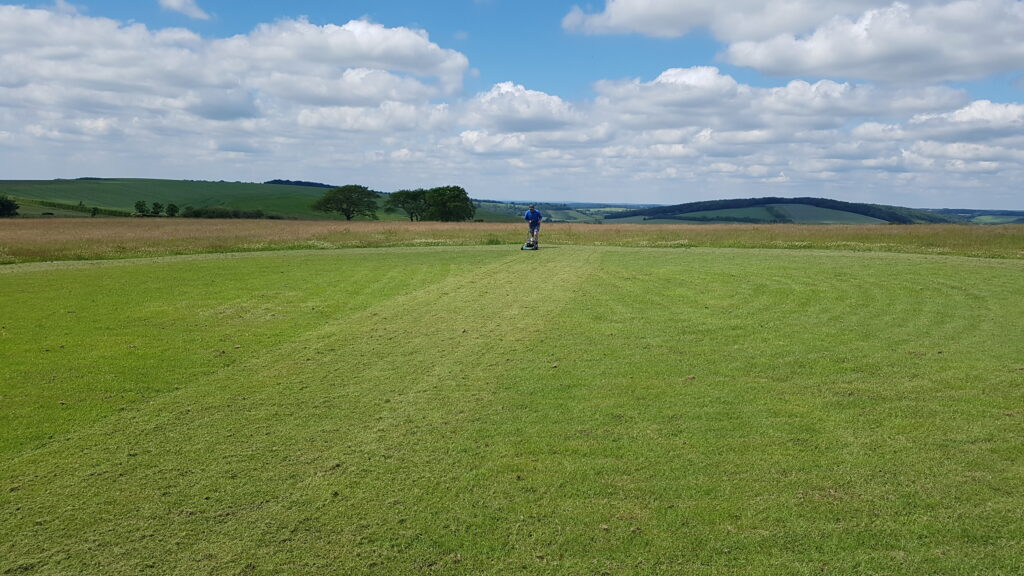 Captain Slow would like you think that he did all the mowing alone but actually all the usual workers were there as well. The grass on the rest of the field has been getting extremely long and as I write Woody has just said that it’s being cut at this very moment. Presumably Farmer George will soon be baling it ready to use as winter feed.
Captain Slow would like you think that he did all the mowing alone but actually all the usual workers were there as well. The grass on the rest of the field has been getting extremely long and as I write Woody has just said that it’s being cut at this very moment. Presumably Farmer George will soon be baling it ready to use as winter feed.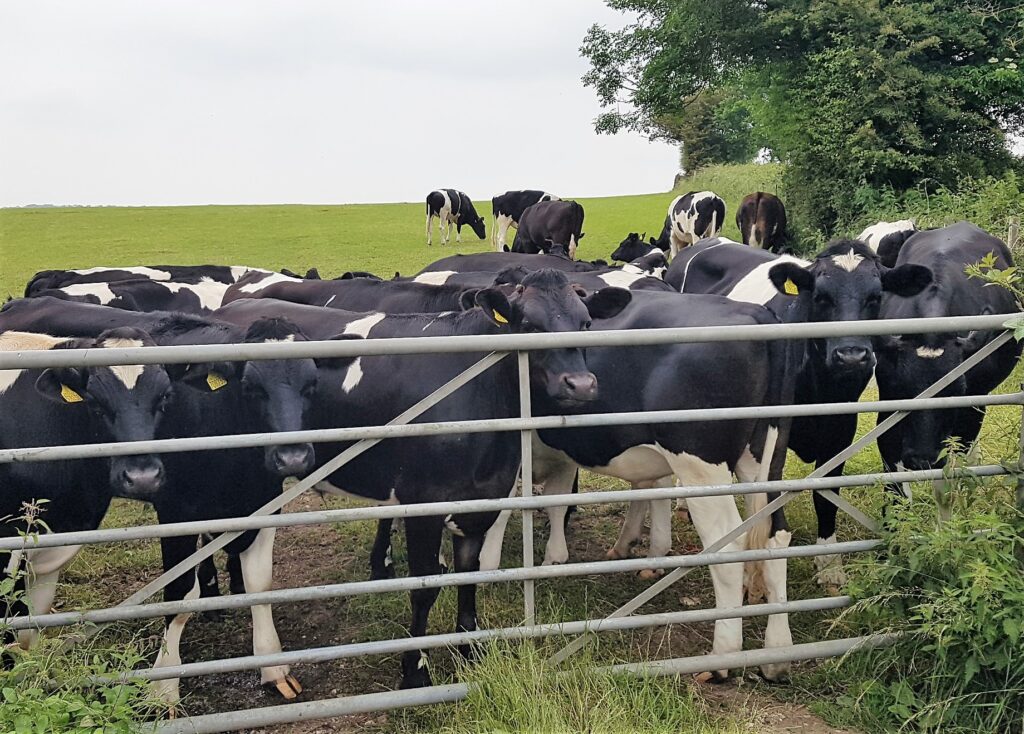 This is a herd of inquisitive young bullocks in the lower field which I imagine will arrive in our field before too long.
This is a herd of inquisitive young bullocks in the lower field which I imagine will arrive in our field before too long.
I’ll begin this edition with congratulations to Richard Osborn who passed his BMFA ‘A’ test so can now fly without the need to have someone supervising him. Although the flying part of the test hasn’t changed for several years the theory part has recently got much more complicated as all unmanned aircraft operations in the UK must now adhere to the eighth edition of the CAA CAP 722 Unmanned Aircraft System Operations in UK Airspace.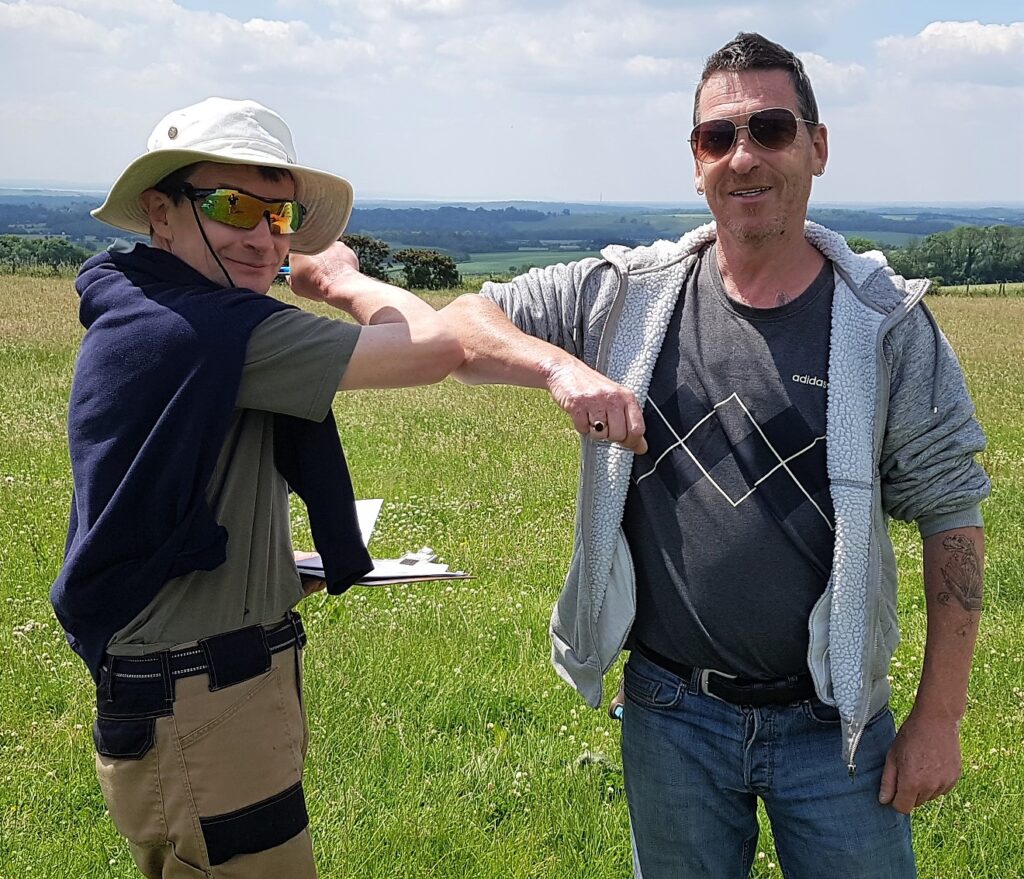 It’s all very simple, just download the 238 page document and learn it! Fortunately BMFA members can choose to conform to the CAA Article 16 Authorisation instead, a mere 14 pages. So next time you are wondering what the BMFA does for you remember that it saved you having to read 224 extra pages of stuff that is mostly irrelevant to what we do! Fortunately Richard had previously taken and passed the online BMFA Registration Competency Test.
It’s all very simple, just download the 238 page document and learn it! Fortunately BMFA members can choose to conform to the CAA Article 16 Authorisation instead, a mere 14 pages. So next time you are wondering what the BMFA does for you remember that it saved you having to read 224 extra pages of stuff that is mostly irrelevant to what we do! Fortunately Richard had previously taken and passed the online BMFA Registration Competency Test.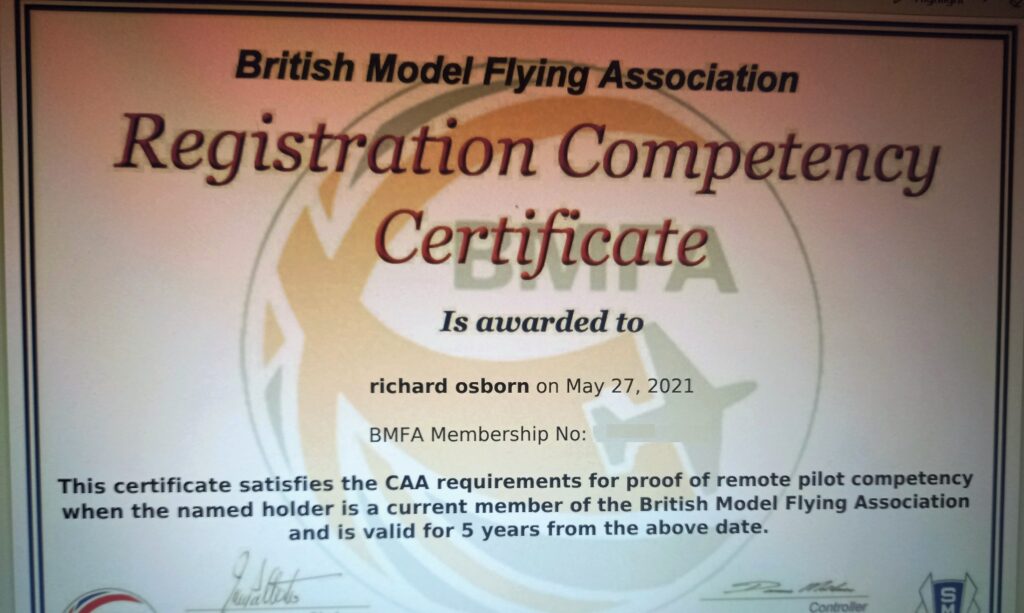 This meant he didn’t have to answer the Mandatory Questions as part of his ‘A’ test, just a minimum of 5 questions from the BMFA Safety Codes and PAM club rules. Although not mandatory it’s a good idea for all members to take the online test and register it alongside their BMFA membership. You’ll find it at https://rcc.bmfa.uk/rcc All fliers are required to display their Operator ID on all their models but of course you have all done that already haven’t you?
This meant he didn’t have to answer the Mandatory Questions as part of his ‘A’ test, just a minimum of 5 questions from the BMFA Safety Codes and PAM club rules. Although not mandatory it’s a good idea for all members to take the online test and register it alongside their BMFA membership. You’ll find it at https://rcc.bmfa.uk/rcc All fliers are required to display their Operator ID on all their models but of course you have all done that already haven’t you?
Club members managed a lot of flying during the month and several new models made it up to the patch to be test flown, many of which belonged to Chas Butler, he successfully test flew no less than five new models in June!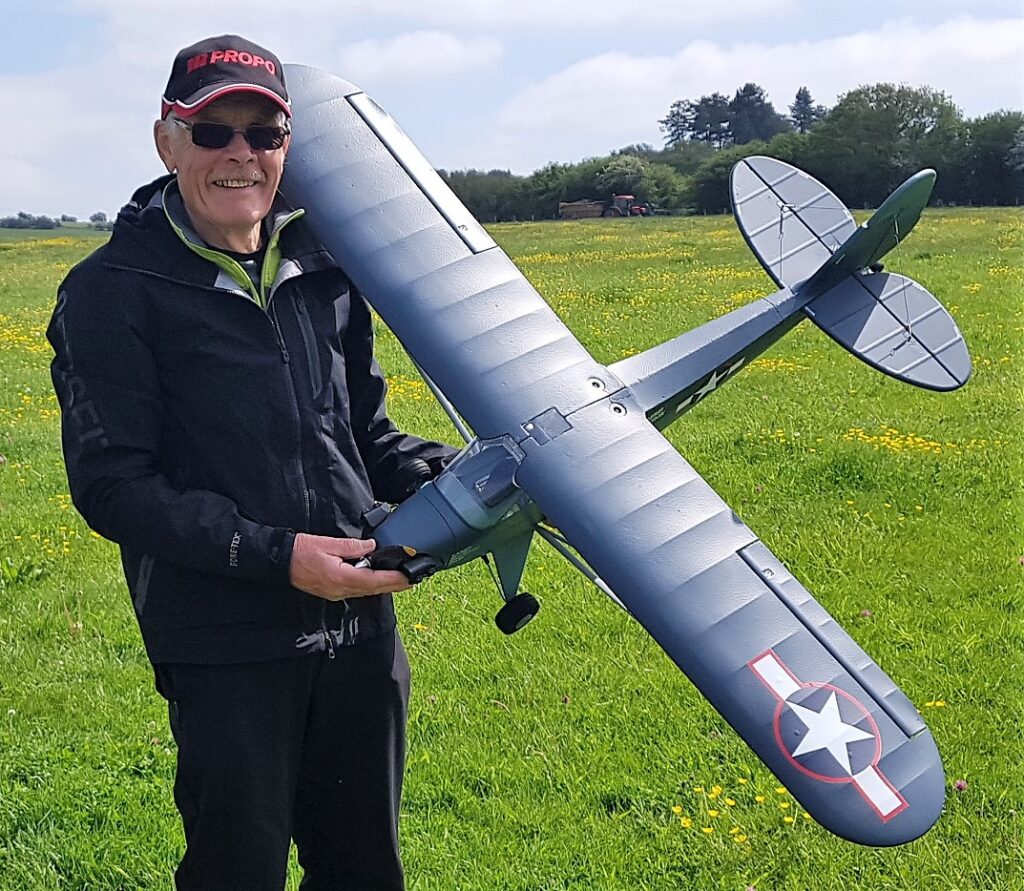 So I’ll kick off with one of his, a US Navy Cub, this is what Chas says about it: The HobbyKing US Navy Cub comes pre-fitted with a 3648 700Kv motor with a 45amp ESC and four servos. The landing gear assembly instructions were a bit vague and I have reservations about its durability. After four flights two of the tensioning springs have broken.
So I’ll kick off with one of his, a US Navy Cub, this is what Chas says about it: The HobbyKing US Navy Cub comes pre-fitted with a 3648 700Kv motor with a 45amp ESC and four servos. The landing gear assembly instructions were a bit vague and I have reservations about its durability. After four flights two of the tensioning springs have broken.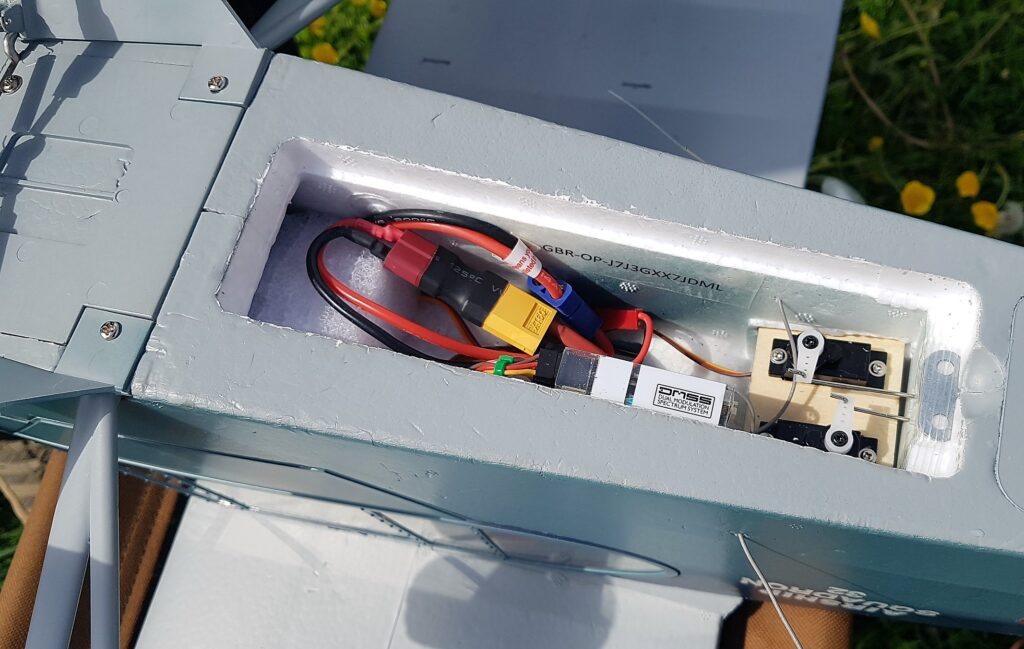 Suggested batteries are either 3s or 4s with a 2200mAh capacity. I’ve only tried 4s batteries so far and there is plenty of thrust from the 12 x 6 scale’ish propeller. There was a tendency for the model to try to ground loop on the first attempt to take off but using a lower rate on the rudder/tailwheel makes this easier to avoid.
Suggested batteries are either 3s or 4s with a 2200mAh capacity. I’ve only tried 4s batteries so far and there is plenty of thrust from the 12 x 6 scale’ish propeller. There was a tendency for the model to try to ground loop on the first attempt to take off but using a lower rate on the rudder/tailwheel makes this easier to avoid.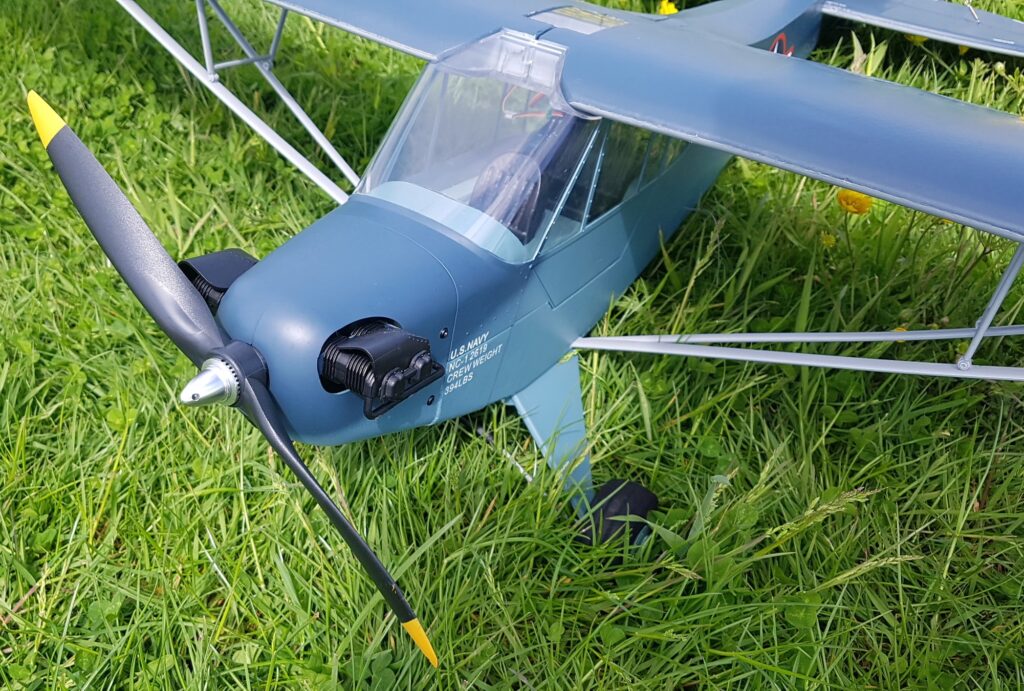 It flies very well and turns nicely with a little rudder added to the aileron and flight times of seven minutes have only used about 60% of battery capacity. Thanks for that Chas. If I remember correctly the HobbyKing US Navy Cub is the same model as 1066’s US Army Cub with only the colour scheme being different. I know 1066 also had trouble with the undercarriage, both assembly and durability, and I think he replaced it completely eventually. Of course to stop needing the undercarriage at all Chas could rig up a model of the Brodie System that the Americans used for launching and recovering Cubs and Stinsons at sea. It’s one of those mad things you’d think would never work:
It flies very well and turns nicely with a little rudder added to the aileron and flight times of seven minutes have only used about 60% of battery capacity. Thanks for that Chas. If I remember correctly the HobbyKing US Navy Cub is the same model as 1066’s US Army Cub with only the colour scheme being different. I know 1066 also had trouble with the undercarriage, both assembly and durability, and I think he replaced it completely eventually. Of course to stop needing the undercarriage at all Chas could rig up a model of the Brodie System that the Americans used for launching and recovering Cubs and Stinsons at sea. It’s one of those mad things you’d think would never work:
Woody has built himself an F-22 Raptor from an RC Factory kit that he purchased from Align Trex. When I checked the website it was out of stock but is available from RobotBirds although I don’t think I’d pay £54.41 for one.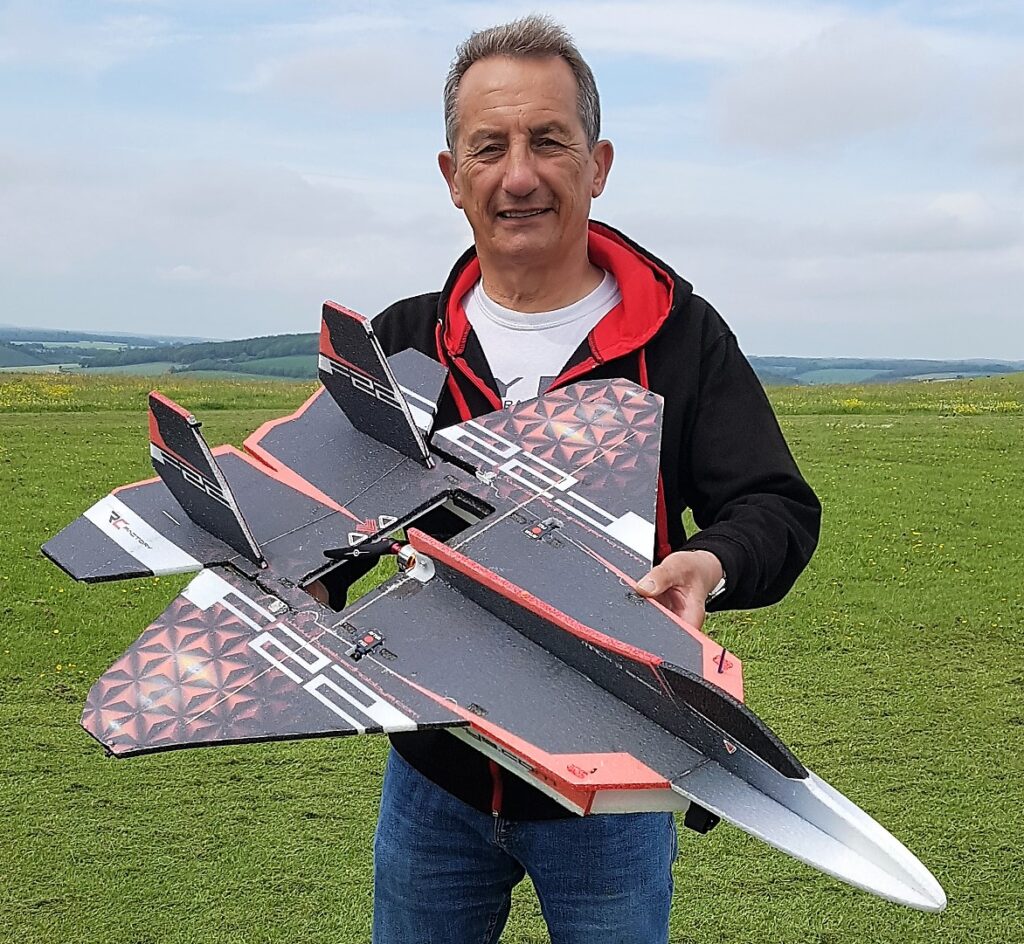
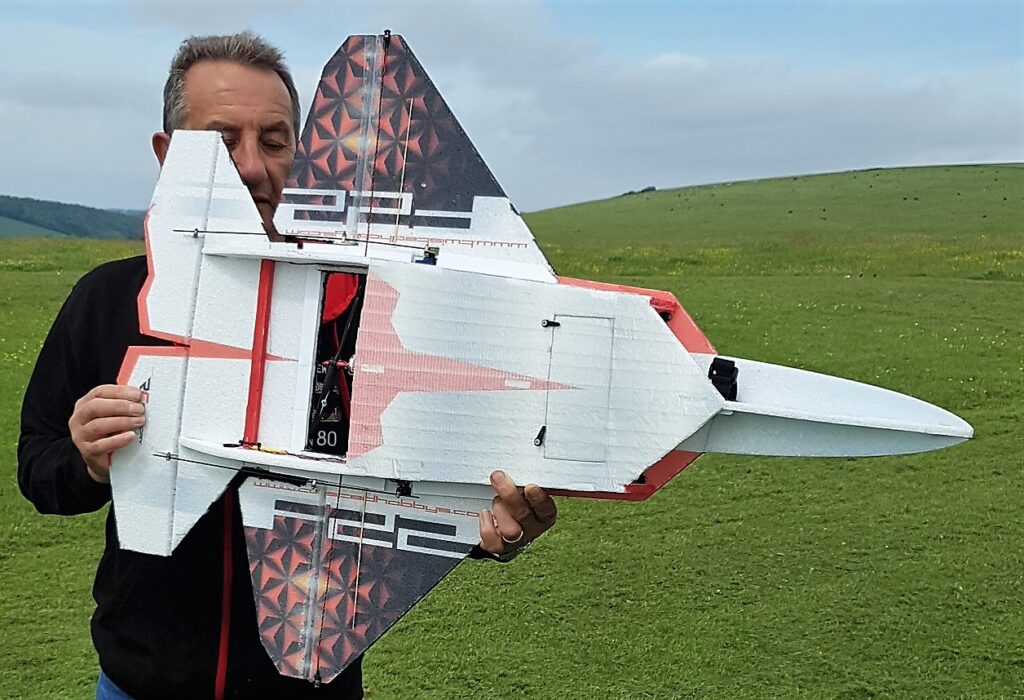 It’s very much along the lines of the foamboard jets that many of us are flying but this one is made from EPP not foamboard. I did the initial test flight at which point the model was fitted with a 1400Kv motor and although it flew fairly well once I’d trimmed it out it definitely needed a higher Kv motor to provide more power.
It’s very much along the lines of the foamboard jets that many of us are flying but this one is made from EPP not foamboard. I did the initial test flight at which point the model was fitted with a 1400Kv motor and although it flew fairly well once I’d trimmed it out it definitely needed a higher Kv motor to provide more power. 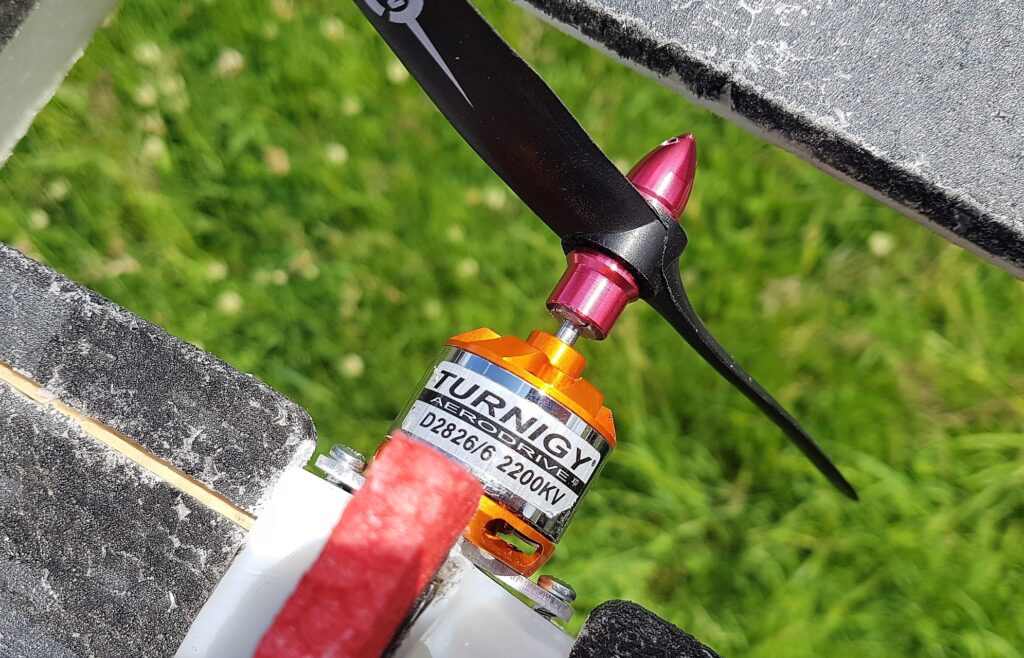 So Woody later swapped the motor for a Turnigy 2826/6 2200Kv and now it performs as it should, just like all the foamboard jets in fact. Woody is using a Turnigy Plush 30A speed controller, two Turnigy 6g servos and lots and lots of lights that were sourced from HobbyKing. He says it now flies much like his Sukhoi SU-57.
So Woody later swapped the motor for a Turnigy 2826/6 2200Kv and now it performs as it should, just like all the foamboard jets in fact. Woody is using a Turnigy Plush 30A speed controller, two Turnigy 6g servos and lots and lots of lights that were sourced from HobbyKing. He says it now flies much like his Sukhoi SU-57.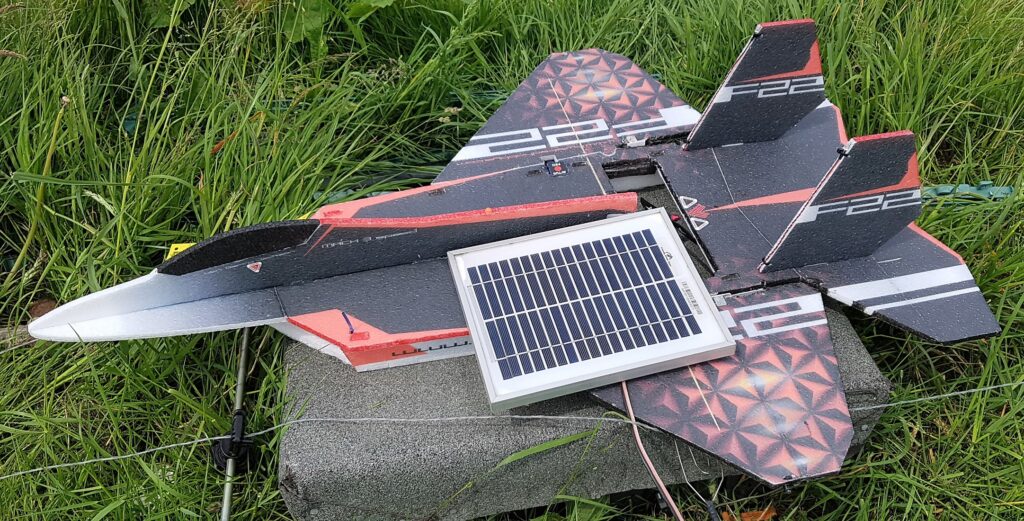 Woody uses 2200mAh 3 cell lipos to power the Raptor and you would expect them to give pretty long flights but he was spotted trying to sneak a bit of extra capacity using the fence solar panel…
Woody uses 2200mAh 3 cell lipos to power the Raptor and you would expect them to give pretty long flights but he was spotted trying to sneak a bit of extra capacity using the fence solar panel…
1066 has now flown the Weston Models Mini-Capiche that I featured in Patch News a few months ago.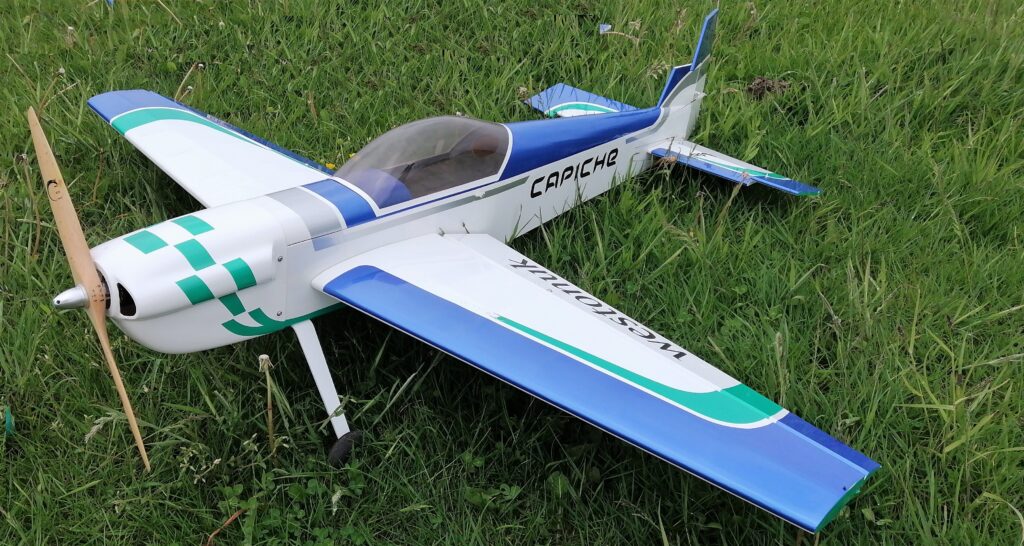
 He had spotted it for sale on Facebook Marketplace and paid £100 for the untouched ARTF kit. 1066 has fitted a 4248 850kv motor that swings a 15×6 propeller. The speed controller is an 80A Turnigy Plush and it’s all powered by a 4 cell lipo. It flies well but 1066 says he’s not sure about it. No doubt he’ll get it sorted to his liking before long.
He had spotted it for sale on Facebook Marketplace and paid £100 for the untouched ARTF kit. 1066 has fitted a 4248 850kv motor that swings a 15×6 propeller. The speed controller is an 80A Turnigy Plush and it’s all powered by a 4 cell lipo. It flies well but 1066 says he’s not sure about it. No doubt he’ll get it sorted to his liking before long.
Dougal Entendre made a substantial change to his Skylark mini pattern ship during June, can you see what he did?
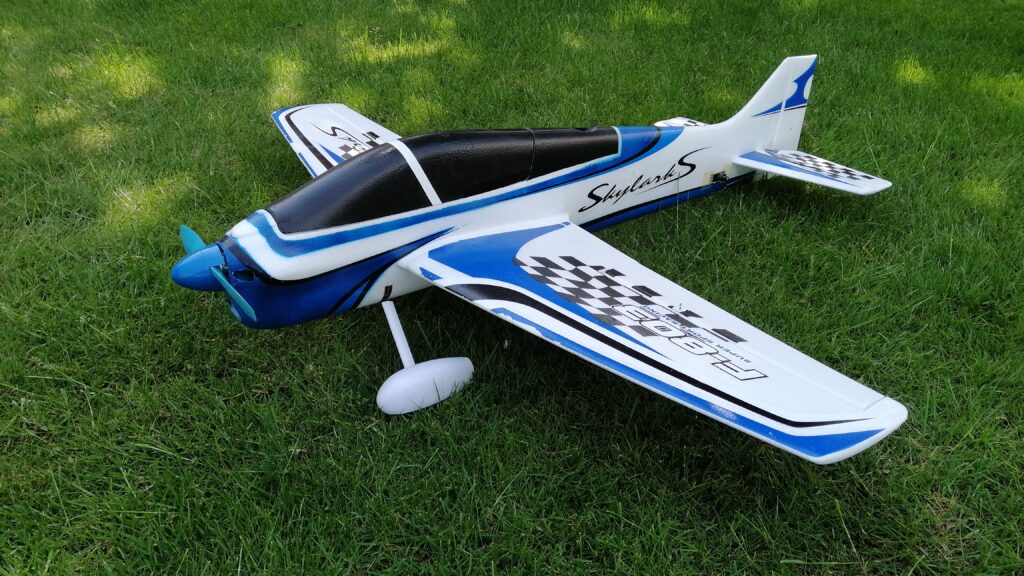 Yes that’s right, he’s added a strip of white tape across the top of the canopy… Wow, what a transformation!
Yes that’s right, he’s added a strip of white tape across the top of the canopy… Wow, what a transformation!
Back to Chas now and the second of the new models he flew in June, an electric glider from Max-Thrust.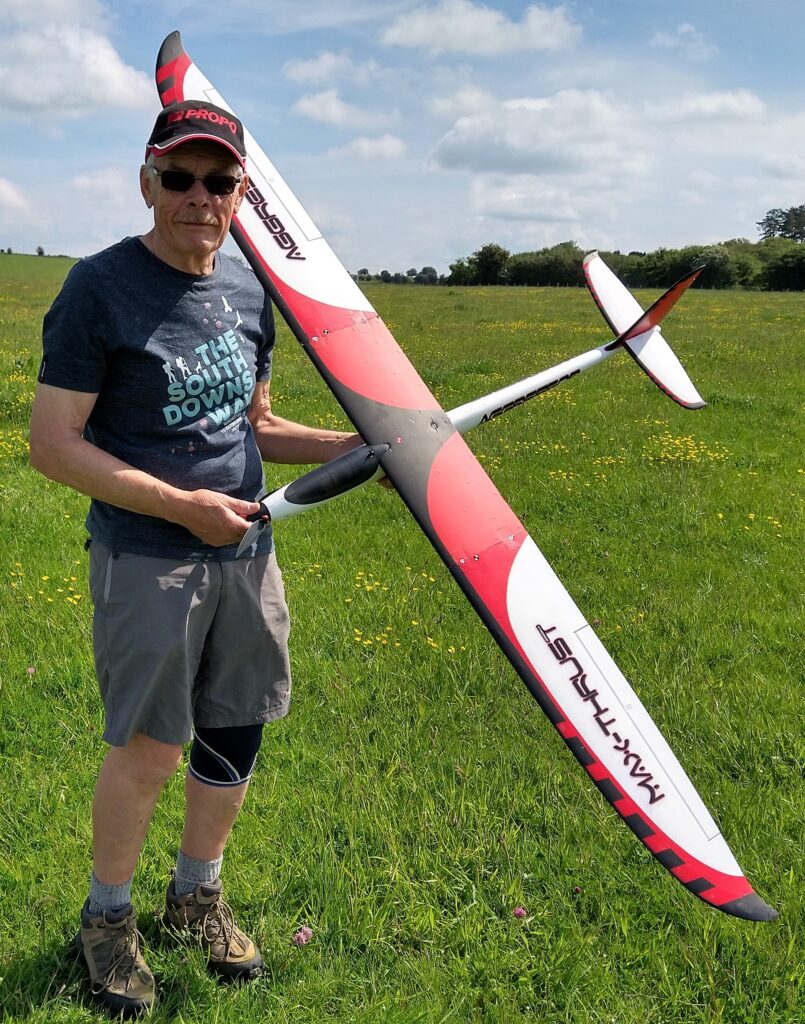 I’d tell you what it’s called but it seems the plane changes its name depending on which way you configure the wing! Chas explains all: The Max-Thrust Aggressor glider is pre-fitted with a 2415 1150Kv motor controlled by a 40amp ESC and four servos. The suggested battery is a 3s 2200mAh but I have used it with a 2900mAh example. This version has a centre wing panel that extends the 1.5 meter Aggressor into a 2.1 meter model called a Thermic.
I’d tell you what it’s called but it seems the plane changes its name depending on which way you configure the wing! Chas explains all: The Max-Thrust Aggressor glider is pre-fitted with a 2415 1150Kv motor controlled by a 40amp ESC and four servos. The suggested battery is a 3s 2200mAh but I have used it with a 2900mAh example. This version has a centre wing panel that extends the 1.5 meter Aggressor into a 2.1 meter model called a Thermic.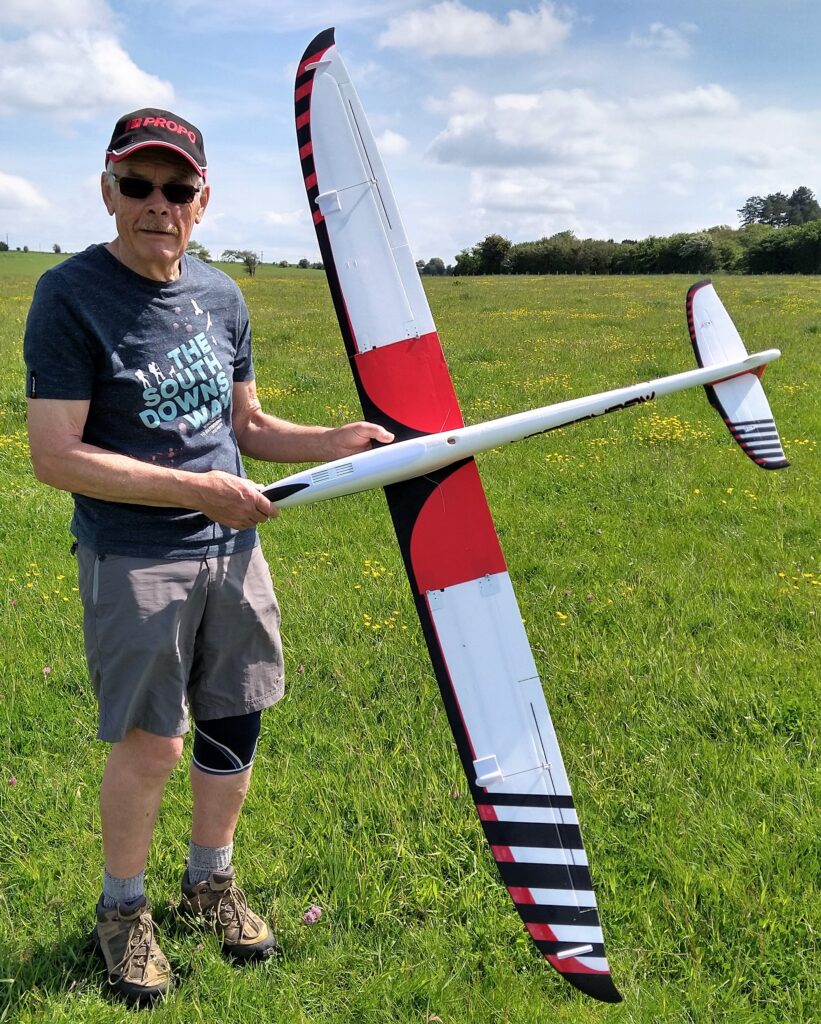 I’ve only flown this glider as the extended wing version. The rate of climb with the 10 x 6 folding propeller is fairly rapid and flying is very pleasant. Landing is smooth but care needs to be taken as the model picks up lift very easily from the slightest little hump, bump or ridge. You can see the Thermic performing in this month’s video where you can see what Chas means about the humps, bumps, and ridges. Captain Slow also has an Aggressor but he didn’t buy the additional centre section extension wing panel so he can’t turn his into a Thermic. He only bought it around eighteen months ago so don’t hold your breath, we won’t see it at the field for a few years yet!
I’ve only flown this glider as the extended wing version. The rate of climb with the 10 x 6 folding propeller is fairly rapid and flying is very pleasant. Landing is smooth but care needs to be taken as the model picks up lift very easily from the slightest little hump, bump or ridge. You can see the Thermic performing in this month’s video where you can see what Chas means about the humps, bumps, and ridges. Captain Slow also has an Aggressor but he didn’t buy the additional centre section extension wing panel so he can’t turn his into a Thermic. He only bought it around eighteen months ago so don’t hold your breath, we won’t see it at the field for a few years yet!
On one of sunnier June days Jeremy Stuttard brought along his E-flite Pulse to fly. As well as being a member of Petersfield Aero Modellers Jeremy is also a member of CADMAC (Chichester & District Model Aero Club) and usually flies with them down at Thorney Island but likes to pay occasional visits to the PAM patch to see what we’re up to.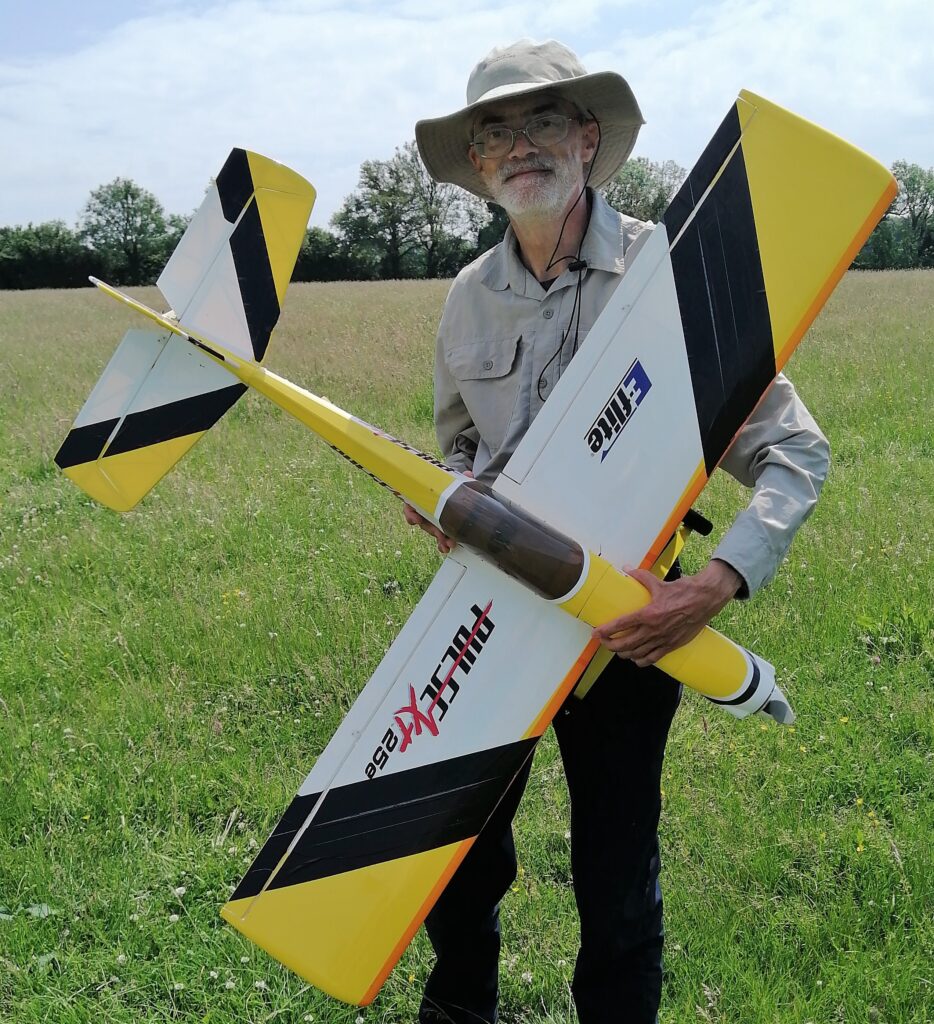 Like all E-Flite models his Pulse flies well and must have had lots of flights, it’s been around for quite a while now.
Like all E-Flite models his Pulse flies well and must have had lots of flights, it’s been around for quite a while now.
June saw the arrival of new member Ian Daniels. Ian started his aeromodelling career with control-line models when he was a child and moved on to radio control at the age of 16 with the Esher & District Model Flying Club. After leaving college Ian got into full-size aircraft working on restoring vintage aircraft for 10 years before moving to work for British Airways at Heathrow for 25 years. He gained and held a PPL for many years but eventually let it lapse. Ian half-heartedly dabbled in slope-soaring until recently but has now decided to swap to fixed-wing power models.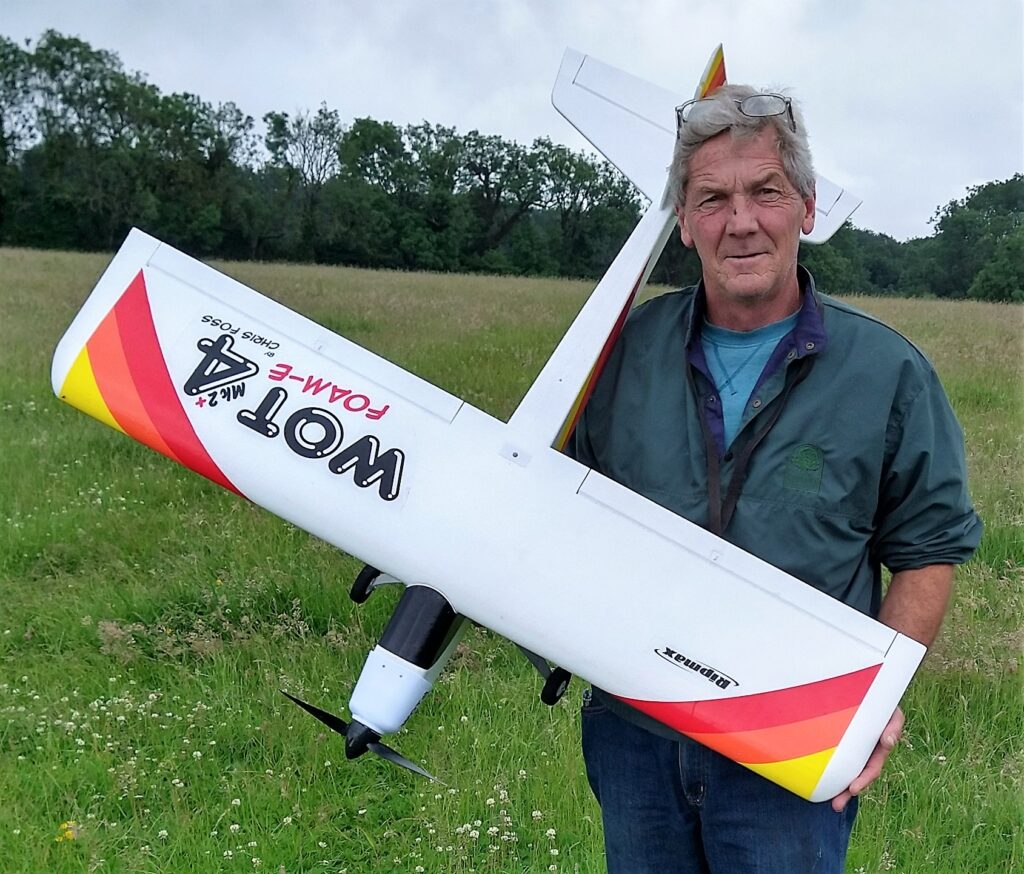 Ian has bought himself a Wot4 Foam-E which, from what I hear, he flew well after 1066 had test flown it for him.
Ian has bought himself a Wot4 Foam-E which, from what I hear, he flew well after 1066 had test flown it for him.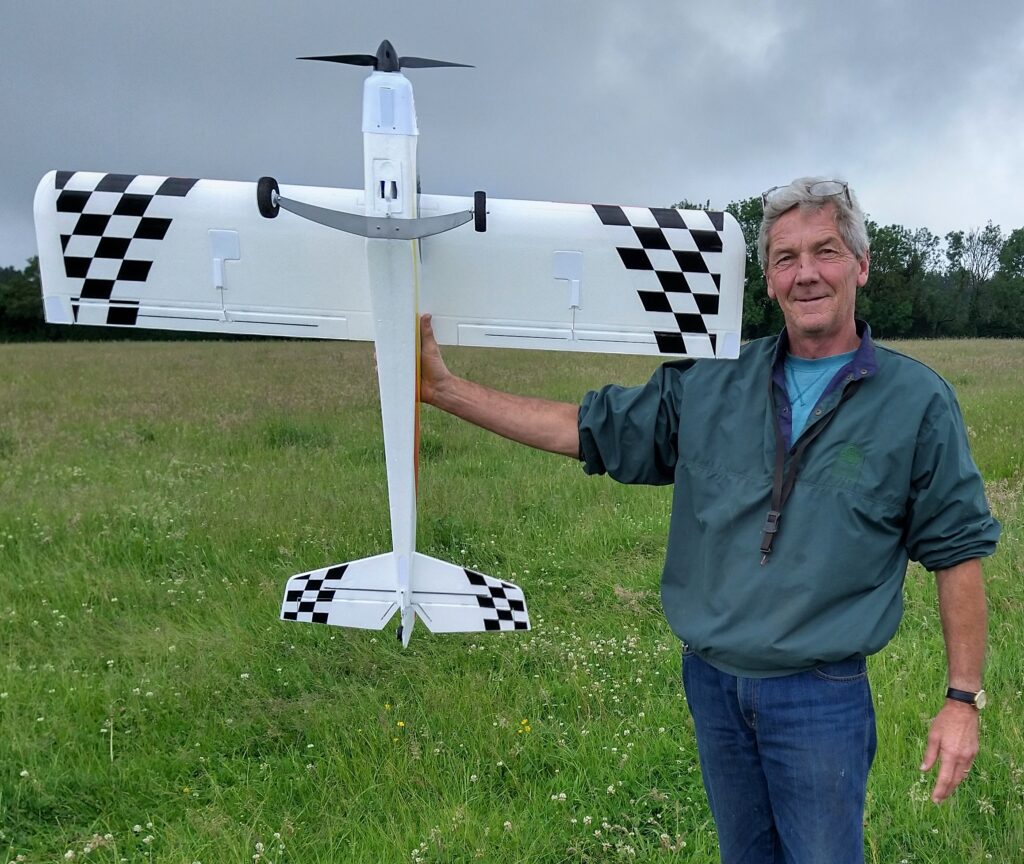 Ian has made the obligatory three visits and paid his subs so is now a fully-fledged member. Welcome to PAM Ian.
Ian has made the obligatory three visits and paid his subs so is now a fully-fledged member. Welcome to PAM Ian.
The third of Chas’s new models is a HobbyKing Walrus: The HobbyKing Walrus comes with a pre-fitted 2212 1350Kv motor with a 20amp ESC. There are also six pre-fitted servos as the glider has flaps fitted as standard.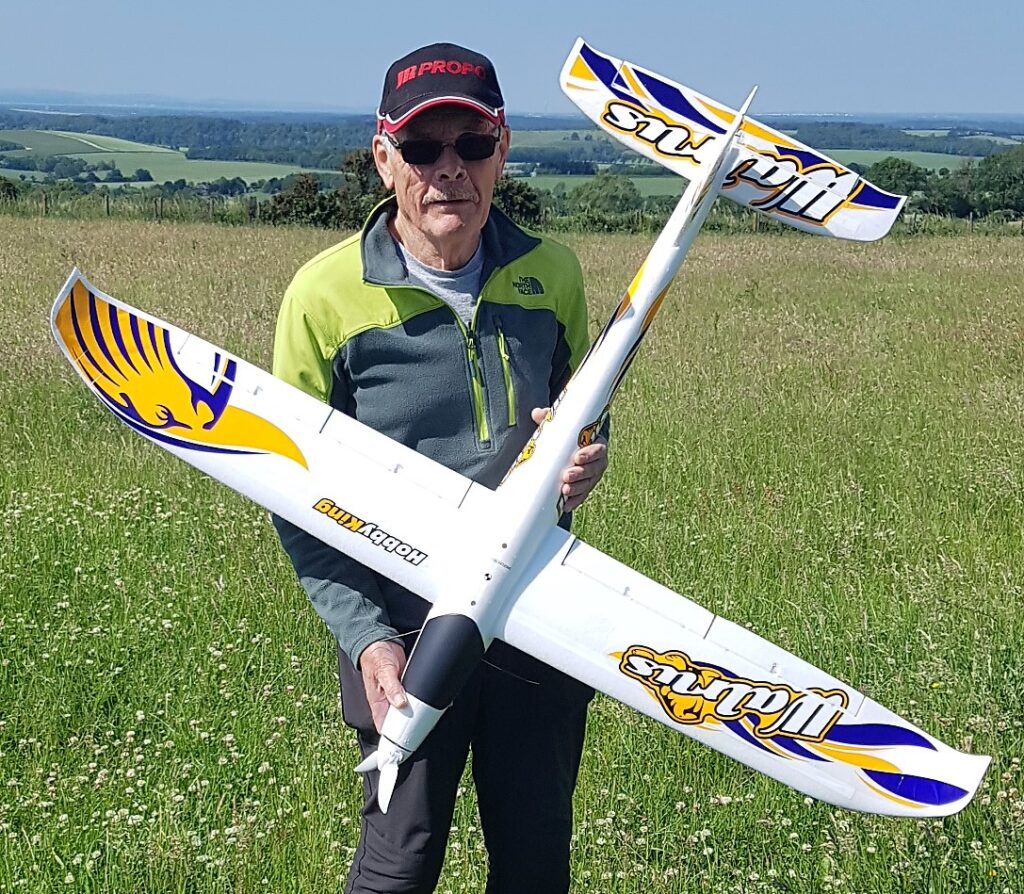 The vertical and horizontal stabilisers should be glued to the fuselage but I’ve modified them so that they are removable for transport purposes. I took this photo to show how Chas has made his Walrus tail removable:
The vertical and horizontal stabilisers should be glued to the fuselage but I’ve modified them so that they are removable for transport purposes. I took this photo to show how Chas has made his Walrus tail removable: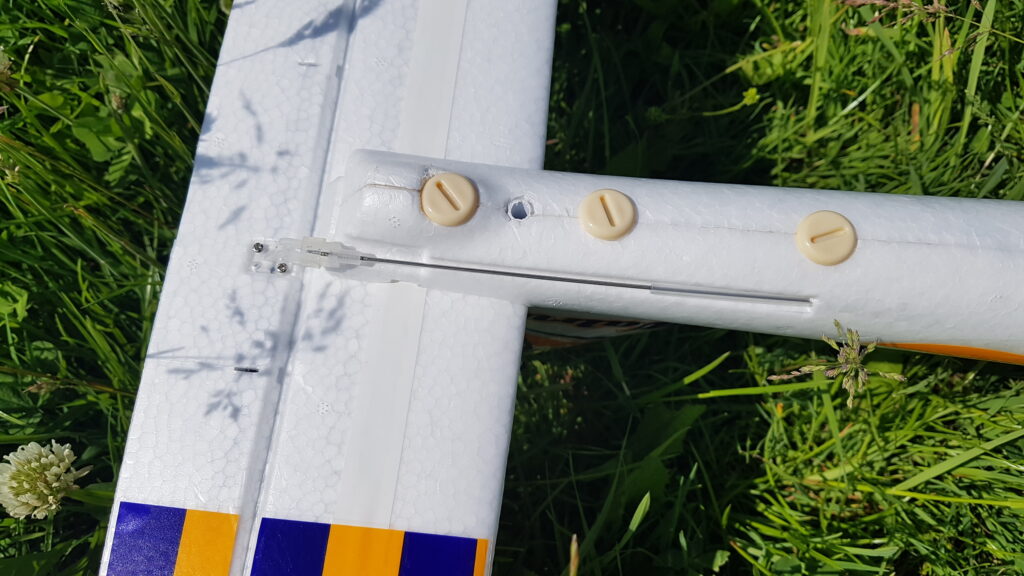 The included instructions state a 3s 1300mAh battery is required whereas the website suggests a 3s 2200mAh item. I went with the 2200mAh option and the C of G has come out spot on with the battery almost as far forward as it will go. Although the fuselage looks spacious the amount of room for the receiver is fairly limited. For this reason I’ve fitted the seven channel JR receiver inside the canopy base. I’ve also re-routed the wing servo leads as it took me about 15 minutes to assemble the two piece wing to the fuselage with a carbon fibre wing joiner whilst feeding the leads through a barely accessible aperture in the fuselage. They now run forwards to the wing leading edge within the fuselage mounting area. The model flies on the 9 x 5 folding propeller without any serious issues although the ailerons are a bit sluggish. I’m going to play around with differential and may use the spare receiver channel to allow the flaps to be programmed to act as inboard ailerons. Excellent Chas, it should make a great holiday model.
The included instructions state a 3s 1300mAh battery is required whereas the website suggests a 3s 2200mAh item. I went with the 2200mAh option and the C of G has come out spot on with the battery almost as far forward as it will go. Although the fuselage looks spacious the amount of room for the receiver is fairly limited. For this reason I’ve fitted the seven channel JR receiver inside the canopy base. I’ve also re-routed the wing servo leads as it took me about 15 minutes to assemble the two piece wing to the fuselage with a carbon fibre wing joiner whilst feeding the leads through a barely accessible aperture in the fuselage. They now run forwards to the wing leading edge within the fuselage mounting area. The model flies on the 9 x 5 folding propeller without any serious issues although the ailerons are a bit sluggish. I’m going to play around with differential and may use the spare receiver channel to allow the flaps to be programmed to act as inboard ailerons. Excellent Chas, it should make a great holiday model.
The foamboard jets that many of us fly are pretty much indestructible as well as being extremely manoeuvrable and capable of flying both quite quickly and very slowly. So there is a temptation to attempt to fly in close formation and occasionally the models inadvertently touch. Fortunately because the motors are centrally mounted these generally result in nothing more than a small nick or two in the foamboard. But there seems to be a disproportionately high number of these touches between Captain Slow’s Mig and my Sukhoi which I can only attribute to the Captain’s wild aggressiveness. One recent touch ended with the models becoming locked together and ending up like this!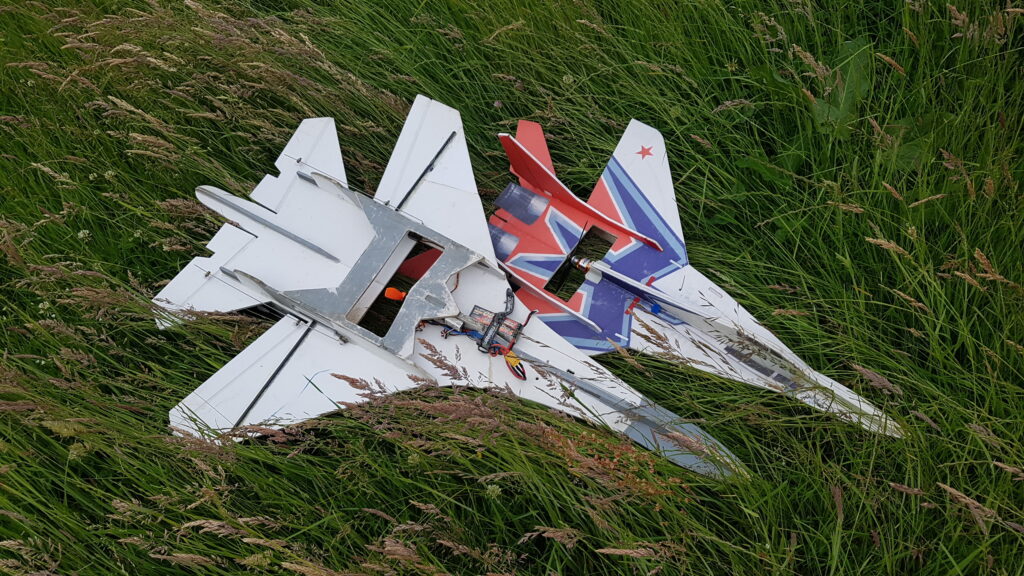 Of course certain elements of what I’ve written above might be open to debate by others… especially Captain Slow!
Of course certain elements of what I’ve written above might be open to debate by others… especially Captain Slow!
Back to Chas again now for his fourth new model, his Wot4 Classic that I featured in Patch News last month.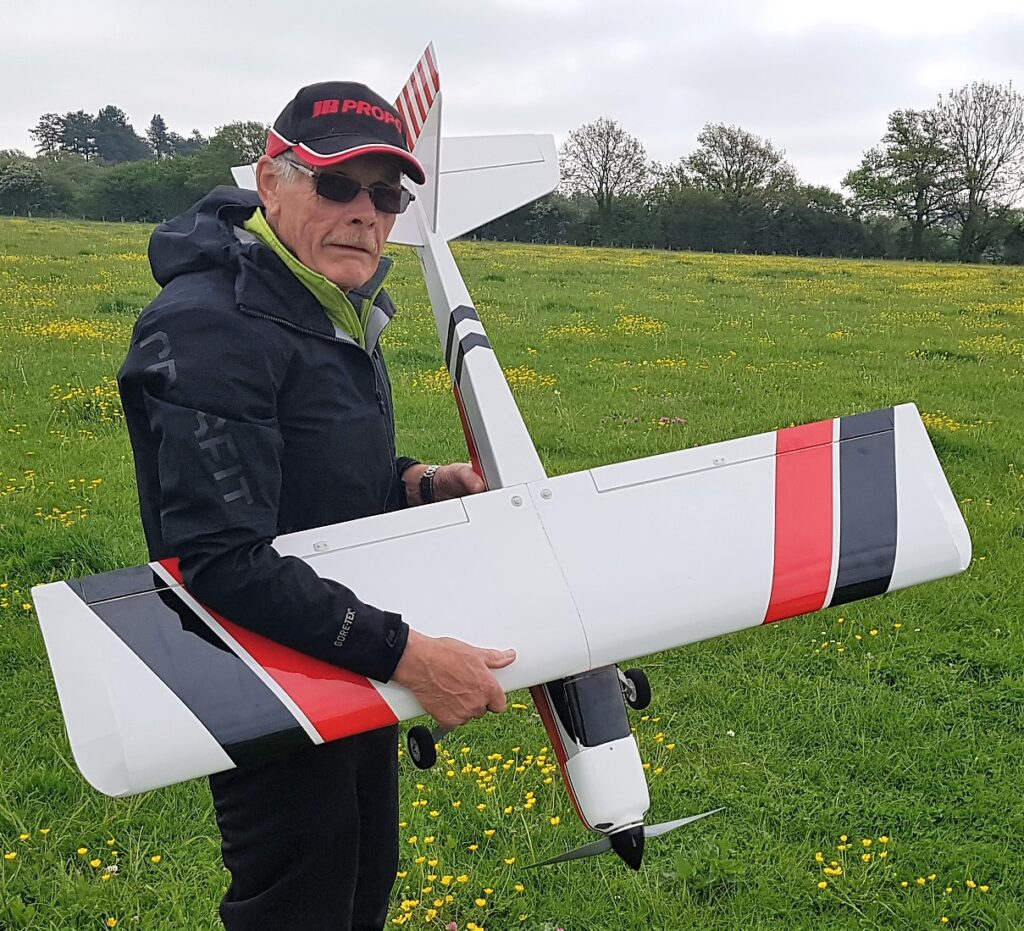 Chas’s Wot4 Classic is actually eleven years old but it has barely flown and Chas has now swapped out the original IC engine for an electric motor so it’s now quiet and clean. His fifth new model to fly was yet another Wot4 but this one’s the Mini version. No pictures or info this month, you’ll have to read the July Patch News to find out about it.
Chas’s Wot4 Classic is actually eleven years old but it has barely flown and Chas has now swapped out the original IC engine for an electric motor so it’s now quiet and clean. His fifth new model to fly was yet another Wot4 but this one’s the Mini version. No pictures or info this month, you’ll have to read the July Patch News to find out about it.
Unfortunately I don’t have any new flying shots from Kryten this month but here are some of his great photos from previous months, some of which I haven’t used before: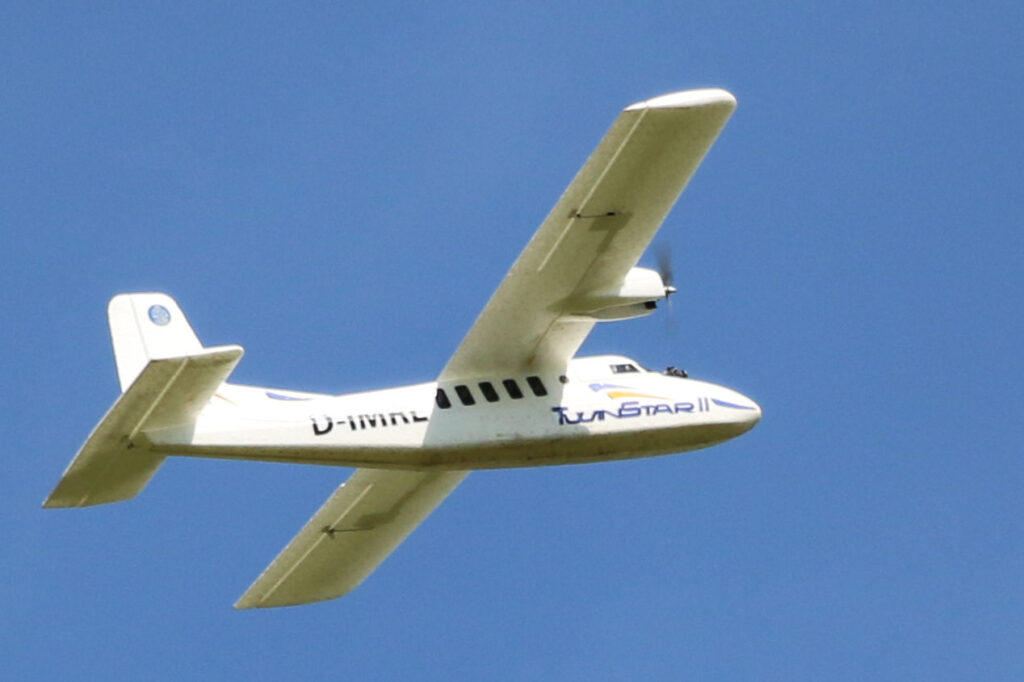
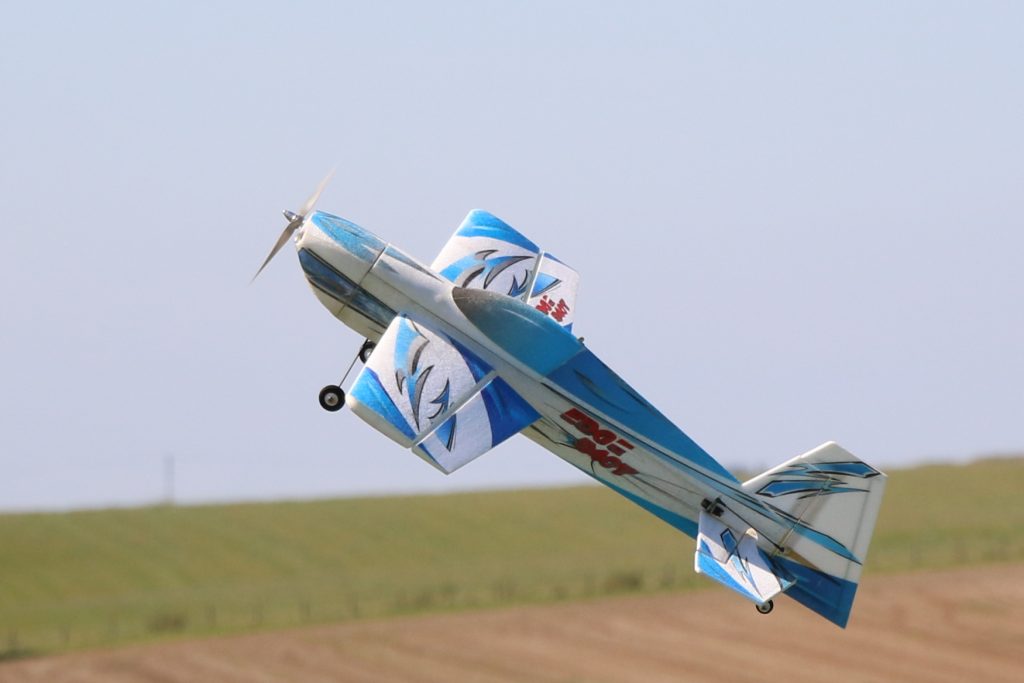
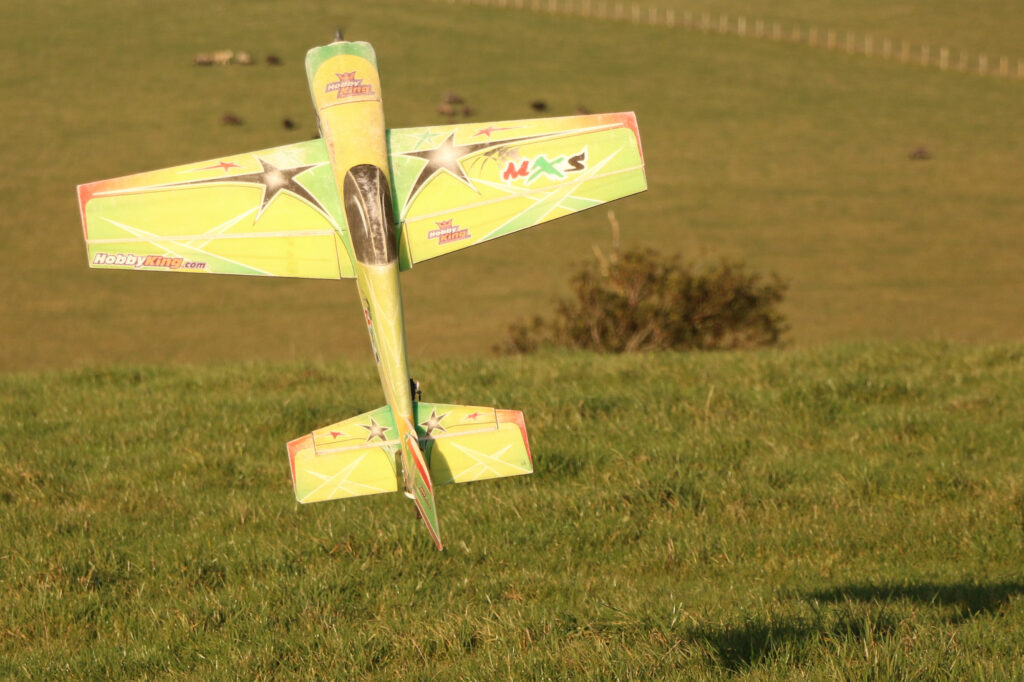
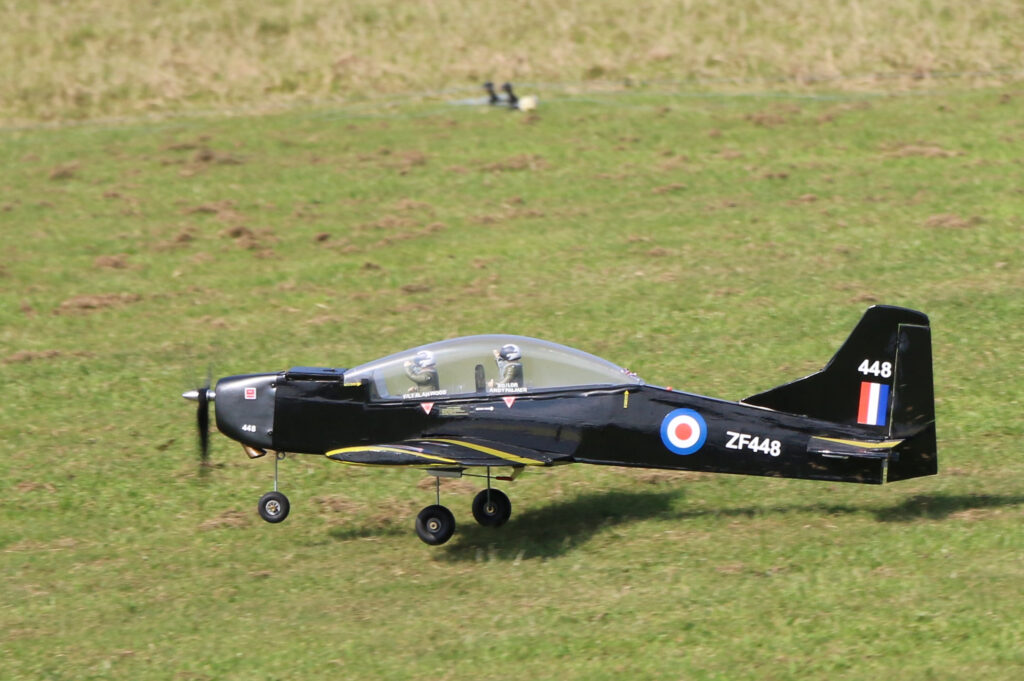
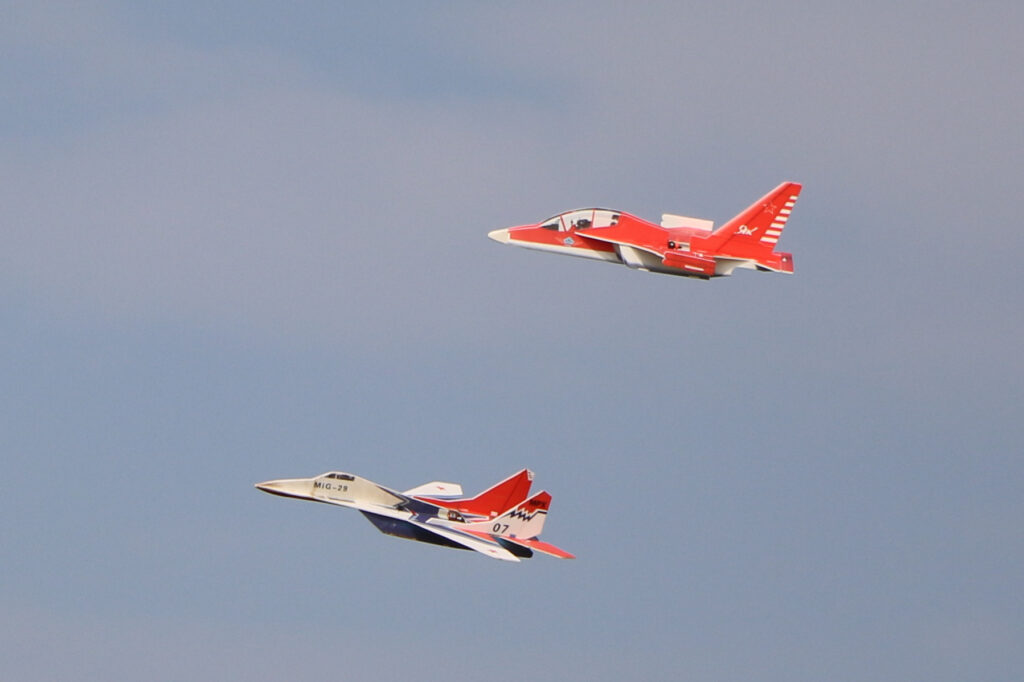
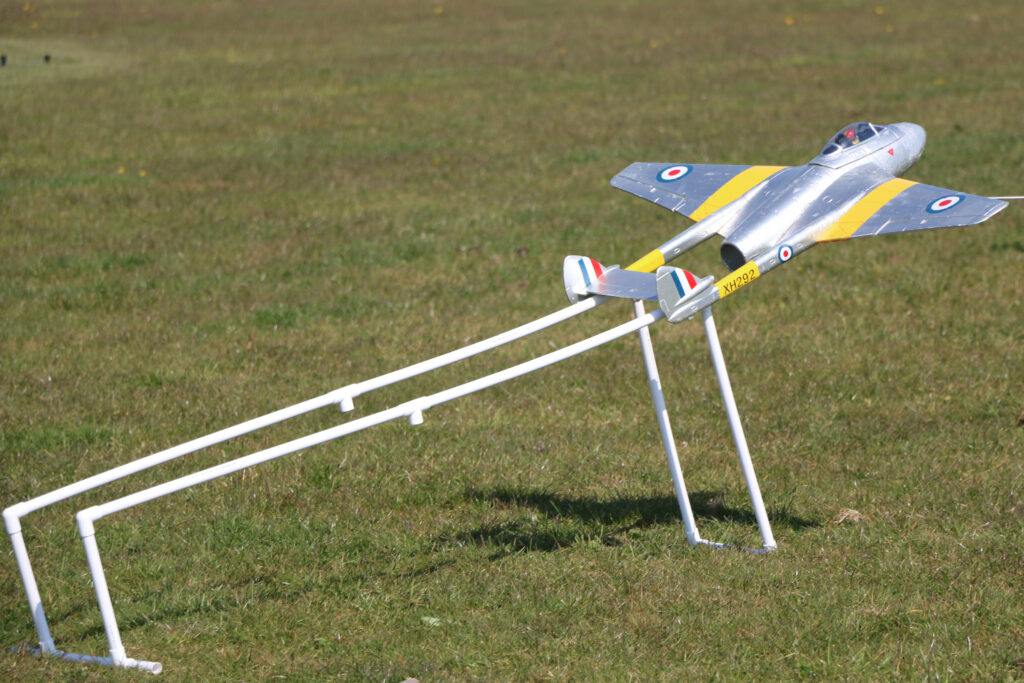
Video time now which this month includes some taken by me, Dougal, and Captain Slow. Please watch the video full-screen, it’s so much better with small models flying around.If the video won’t play for you please click HERE
A Lufthansa pilot landed his Airbus A320 at London’s Heathrow Airport. Later an Operations Manager spoke to him and asked if he’d had any trouble landing the plane since there was a strong crosswind.
“Nein,” the pilot answered, “I let Otto land the plane.”
“Otto? Is that your co-pilot?”
“Nein, my co-pilot was Frederick, and I would not trust my life with him, or my passengers.”
Startled, the Ops guy asked, “So, then who is Otto?”
“Otto-pilot, perfect landing every time.”
Colin Cowplain


Well done Colin, another enjoyable read